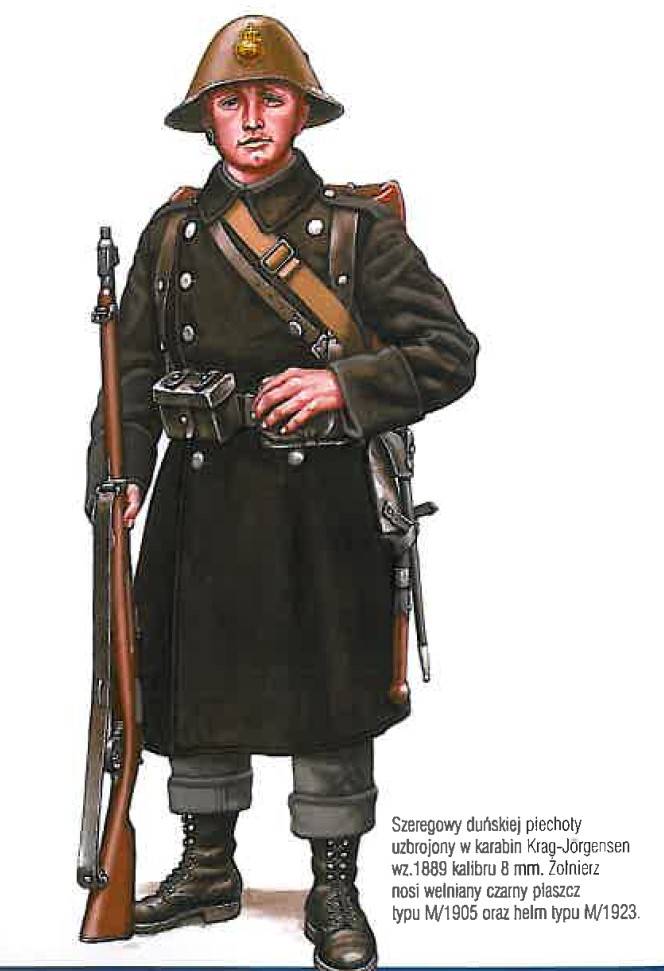
Fallschirmsjäger Denmark 1940. German paratroops used at the invasion of the Denmark on 9th April 1940 were dislocated. 4. Komp./1. Fallsch.Jg.Rgt. was used in Denmark. One platoon was used at the airport of Aalborg and that three platoons were landed at the Masnedø bridge on Falster.
The small nation of Denmark with a population of some 5 million people had since 1815 sought security in neutrality, and indeed the country was neutral during World War I. As additional insurance, it signed a nonaggression pact with Germany in the spring of 1939. Although Denmark’s chief trading partner was Great Britain, which received Danish exports of dairy products, it was clear that Denmark lay within Germany’s sphere of influence. Its conquest by Germany was a natural extension of Operation WESERÜBUNG, Adolf Hitler’s plan to take Norway in April 1940. German occupation of Denmark was essential if Germany was to control Norway.
At the time of the German invasion, Denmark had an army of 14,000 men, 8,000 of whom had been recently drafted. The small navy had only 3,000 men and 2 coast defense warships (built in 1906 and 1918). The air force, split between the army and navy, had 50 obsolete aircraft. The German invasion, mounted before dawn on 9 April 1940, was over in only 2 hours. The government ordered a cease-fire after the occupation of Copenhagen, leaving insufficient time for the government or King Frederik IX to get abroad.
Code-named Operation WESERÜBUNG SUD (WESER EXERCISE SOUTH), the German invasion of Denmark began at approximately 4:15 A. M. on 9 April 1940. It formed an integral part of the much larger German assault on Norway (Operation WESERÜBUNG) that began the same day. German units quickly overran the Danish Peninsula, abrogating a nonaggression pact signed between Germany and Denmark in May 1939.
Although Danish intelligence learned of the German plans to invade as early as 4 April, the accounts were contradictory, and in any case were not believed. Certainly, the Danes had no chance whatsoever of defeating the German invaders. The poorly trained and inadequately equipped Danish army numbered only some 14,000 men, 8,000 of whom had enlisted within 8 weeks prior to the German attack. The Danish navy consisted of just 2 small vessels and approximately 3,000 men. The navy surrendered without going on alert, allowing a German troopship to arrive at Copenhagen. The Air Force had only 50 obsolete planes and a handful of pilots, no match for the vaunted Luftwaffe.
On 9 April, German seaborne forces moved into the capital of Copenhagen and secured the city by 6:00 A. M. Mean- while, German paratroopers conducted the first airborne operation of the war when they seized the undefended fortress of Madneso and, shortly thereafter, the airport at Aalborg in north Jutland. At the same time, German army units raced across the Jutland Peninsula in motorized columns. Although Danish Army units briefly contested the Germans in north Schleswig, the outcome was never in doubt.
German minister to Denmark Cecil von Renthe-Fink presented an ultimatum to the Danish government, demanding surrender and threatening the destruction of Copenhagen by Luftwaffe squadrons already en route if it refused. There was absolutely no chance of victory over the Germans, and eager to avoid further loss of life, King Christian X and Premier Thorvald Stauning believed they had no choice but to order surrender at 7:20 A. M. The campaign for Denmark was over. Danish casualties amounted to 26 dead and 23 wounded; the Germans lost 20 dead and wounded.
The German invasion provided the excuse for the Allied occupation of Iceland, which belonged to Denmark. Allied possession of strategically located Iceland proved vital in the Battle of the Atlantic. German forces occupied Denmark until the end of the war in May 1945.
Danish Air Power 1940
Before the war Denmark was extremely unprepared having downgraded its military force. The air defence was divided into the Naval Air Service and the Army Flying Corps.
The Naval Air Service had a squadron of outdated Hawker Nimrod (Danish version of Fury) fighters and seaplanes. Some were for use in Greenland and there was a growing interest in torpedo launching.
The Army Flying Corps had Gloster Gauntlets fighters and was upgrading to Fokker D XXI fighters. The first was bought in Holland the rest were built in Denmark. A Danish production of Fairey Battle bombers had started but none were finished. Licence to build the Fokker G-1 heavy fighter was acquired.
On the morning of April 9th 1940 the German occupation started finding Denmark as unprepared as many other countries.
An attack by a stafel of ME-110 fighters destroyed most planes at the Vaerloese Army Airfield. One Danish aircraft was shot down during takeoff. From that day Danish military aviation stopped. Aircrafts were kept in storage. Some were taken by the German occupation force and reused elsewhere. The majority of the aircraft were destroyed at a later stage by the Danish resistance.
In 1941 two lieutenants managed the refurbish a deHavilland Hornet Moth and to take off for a flight to Britain where one joined to RAF the other served in a special capacity due to his knowledge of German radar systems. In the fall of 1943 another Danish pilot under the same difficult circumstances took off in a deHavilland Moth to fly to England. He joined Special Intelligence Service.
Danes escaping to Sweden also included military personnel. A Danish Brigade was formed very discretely due to Swedish neutrality. This brigade also had a Danish flying squadron. It was flying as a part of the Swedish air force. The squadron was nominated to 15 SAAB B-17 dive bombers intended for ground support for the brigade when it should participate in the recapture of Denmark.
The German forces surrendered on May 5th 1945 and the fighting following was relatively light. The brigade did not use the air support. The squadron was flying in Swedish colours until May 5th when all planes were painted in Danish colours.